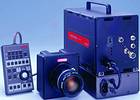
Sports followers will be familiar with high speed photography in the form of the slow motion replays of lbws and run-outs at cricket matches and tries in rugby. The objective of high speed photography is to record an event at very high speed (over a million frames per second [fps]) and to then replay it at slow rates so that what has happened can be studied in detail.
Originally the recording medium was film and many novel methods were developed to run film at high speed through a camera or to attach the film to an arc over which using a rotating mirror the image could be recorded at very high speeds (up to 25 million fps) with a limited number of frames. The problem with these cameras was that a very accurate trigger was required to synchronise to the event and that the film had to be developed.
While high speed photography was mainly of interest for studies of missiles and other ballistic and explosive devices it more recently came into vogue for the determination of faults on high speed production equipment and with commercial explosives manufacturers. The technique has great importance in the mining industry where it can be used to study the effectiveness of blasting techniques. Other recent applications include the study of the movement of athletes playing sports such as cricket and golf, the development and batch testing of vehicle airbags (the most recent: side-mounted air bags that inflate in less than 5 ms) and simulated vehicle crash tests where multiple cameras record the event from all angles. Another interesting use is the study of combustion of fuel in an engine cylinder in test with quartz viewing windows - particularly important with lead-free fuel and the use of additives.
The use of high speed photography as a practical tool has however been driven strongly by technology, which has seen the traditional film replaced first by CCD and more recently by improved sensitivity CMOS detectors with array sizes up to 1028 x 1280 pixels. Other technological innovations such as Bayer colour allow full colour imagery with more than one million pixels. Framing speeds for full frame resolution in digital cameras varies between 2000 fps (for 1 million pixels) to 4800 fps (at 500 000-pixel resolution).

The other major benefit that technology has brought is low-cost digital storage and for example, the Photron APX offers three seconds of recording time running at 2000 fps using 8 GB (gigabytes) of memory. The camera system is portable and the lightweight camera head can be mounted on a normal tripod. The advantage of the digital memory is that the camera runs continuously and sequentially overwrites the memory. The need for accurate timing is thus obviated and in many cases the camera can be triggered after the event. The user can also immediately replay what he has recorded on a video or laptop display and can select the actual sequence of the event for immediate memory storage. For events that have no predictability the Photron FASTCAM DVR can record at 500 fps full frame at 640 x 480 pixel resolution for 30 minutes using a 120 GB hard drive. While operation from a laptop is preferable, Photron cameras are also supplied with a handheld control unit.

Digital imagery is very different from film as the frame (be it 512 x 512 or whatever) can be subdivided at reduced resolution to increase the recording speed. Using the Photron APX as an example, it can record full frame (1028 x 1028) at anywhere between 60 and 2000 fps. At a resolution of 512 x 512 pixels this frame rate increases to 4000 per second and this can be extended to a limit of 100 000 fps at a resolution of 128 x 32 pixels. In addition to the framing rate, all cameras are shuttered, exposure time typically going down to a few microseconds, so that image blur does not occur as a result of excessive movement during the exposure.
Some recent applications of high speed photography in the manufacturing sector include the study of atomisers and ink jet heads, the flow of molten steel where colour is a clear indication of temperature, and in destructive testing where a component (electronic, electrical or mechanical) can be stressed to the point of obliteration and the actual sequence can then be studied by design engineers to confirm predictions of analysis software.
As for the quality of imagery that can be attained the best comparison is with normal television. The PAL system used in Europe and South Africa provides 625 lines with up to 440 000 picture elements per frame at 25 frames per second. Remember that while recorded high speed video sequences can be displayed on a TV system, the individual frames can be recorded in JPEG, AVI, TIFF or BMP formats allowing measurement and study of the imagery at the full resolution provided by the chip, already significantly better than your normal TV or video imagery.
Photron has been in the digital high speed camera business for many years (products originally marketed under the Eastman Kodak brand name). The company offers a full range of products (array sizes start at 512 x 480 and go up to 1024 x 1280 pixels) with the cost of a ready-to-use system varying from about $25 000 to $80 000, depending on specification and memory requirements. The use of Photron cameras in South Africa is growing at a rapid pace with five state-of-the art APX systems having been delivered in the last seven months, and interest in other models has been expressed by potential industrial, university and test laboratory users.
For more information contact MIT, 012 348 0569, [email protected], www.measureit.co.za

© Technews Publishing (Pty) Ltd | All Rights Reserved